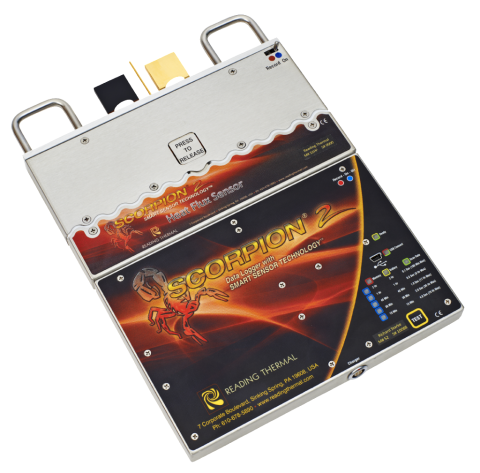Heat flux sensors are used for a variety of purposes across different industries. In the baking industry, they’re essential for creating products with consistent quality and texture. At its most basic level, a heat flux sensor is a device that measures the amount of heat energy flowing through a particular surface over time. Compiling temperature measurements throughout the baking process in an oven under full load allows you to utilize precise data to make adjustments to improve product quality or consistency.
Reading Thermal was founded in 1999 to drive innovation in the baking industry and satisfy the customer’s goal of creating superior products. What began with the original SCORPION® vision evolved into the SCORPION® 2, a cutting-edge profiling system that’s become an industry favorite. The SCORPION® 2 Heat Flux Sensor is an incredibly sensitive tool designed to measure convective and radiant heat fluxes at product level accurately. Even the slightest shift in temperature over time is recorded, providing you with the data you need to create superior baking products.
Measuring Heat Transfer Mechanisms
Heat transfer takes place through three distinct mechanisms:
- Convection
- Conduction
- Radiation
While the band of the Heat Flux Sensor serves as the conduction mechanism, the sensor is designed to measure the results of convective and radiant heat transfer. These results are compiled throughout the baking process under a fully loaded oven, producing real-time data reports. This collected data can be downloaded to an external PC for analysis, using SCORPION® Software (SV8) to translate raw data into visual graph models, including:
- A 2D Line Graph that compares the Qradiant, Qconvective, and Qtotal
- A Total Heat Graph that displays total heat in percentages of convective and radiant heat
2D Line Graph
Heat transfer doesn’t necessarily happen uniformly throughout an entire oven. Certain areas and times may deliver heat unequally, which can be a significant issue if you’re trying to standardize baking. Since the SCORPION® 2 Heat Flux Sensor monitors the entire process, the data collected can illustrate at which point in the process heat changes. This data is represented by three lines – Qradiant, Qconvective, and Qtotal – that show the amount of heat applied at specific times at precise locations across the sensor assembly. Any sharp spikes in these lines indicate a flaw in the process, which can then be fixed as needed.
Total Heat Graph
Ovens bake differently for several reasons, one of which is the amount of proportional energy between different heat sources. The Total Heat Graph creates a visual representation of the total heat in joules used in the baking process and a proportionate comparison between how much convective and radiant heat was utilized. A process that uses a proportion of 75% conductive and 25% radiant will transfer heat differently from one that uses 60% conductive and 40% radiant. Understanding how your oven bakes is instrumental in understanding how to adjust it to fit your ideal baking process and create products according to your specifications.
Whether you’re looking for a way to improve existing recipes or trying to adjust an oven that delivers subpar results, thermal profiling systems like the SCORPION® 2 Heat Flux Sensor are a must-have tool. The SCORPION® 2 Heat Flux Sensor allows you to control the baking process completely, creating products with the exact consistency and quality your customers demand. If you’re interested in our services, call us at (610) 678-5890 Ext. 2, or contact us online for more details about our innovative products.

